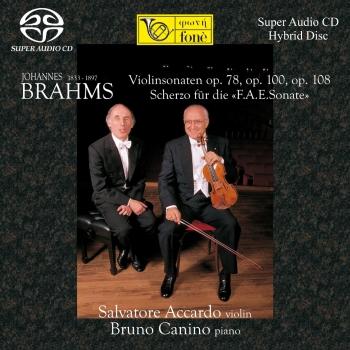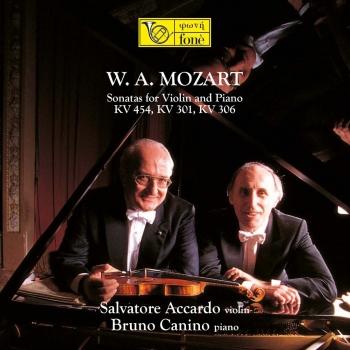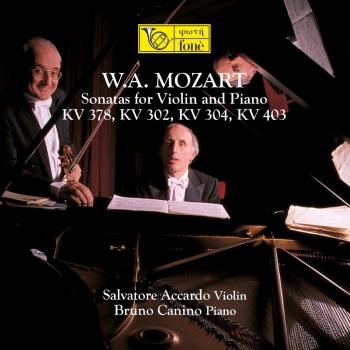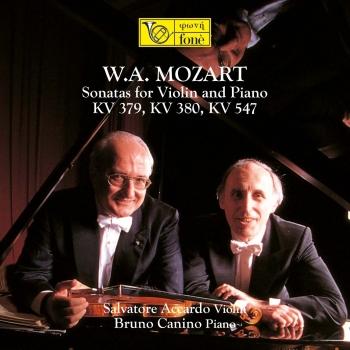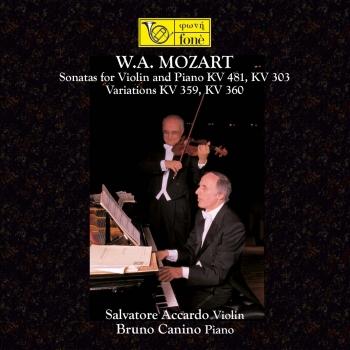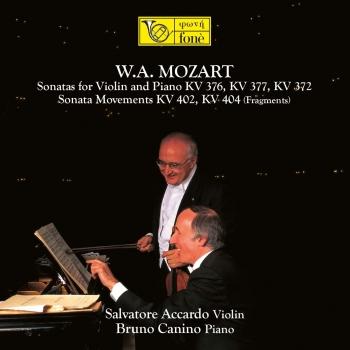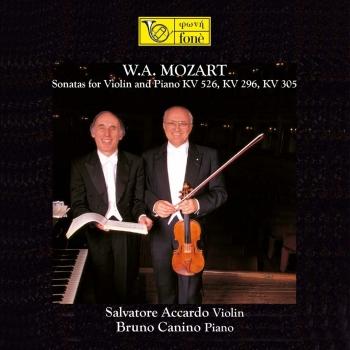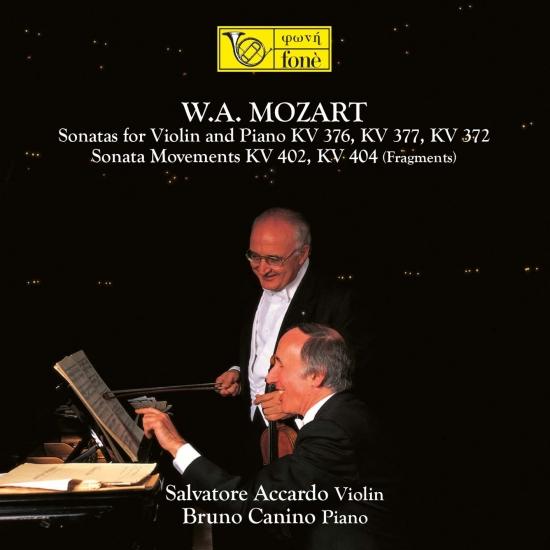
Mozart: KV 376,377,372,402,404 Salvatore Accardo & Bruno Canino
Album Info
Album Veröffentlichung:
2022
HRA-Veröffentlichung:
06.12.2022
Label: fonè Records
Genre: Classical
Subgenre: Instrumental
Interpret: Salvatore Accardo & Bruno Canino
Komponist: Wolfgang Amadeus Mozart (1756-1791)
Das Album enthält Albumcover Booklet (PDF)
- Wolfgang Amadeus Mozart (1756 - 1791): Sonata for Violin and Piano F major KV376, Allegro:
- 1Mozart: Sonata for Violin and Piano F major KV376, Allegro:07:01
- Sonata for Violin and Piano F major KV376, Andante:
- 2Mozart: Sonata for Violin and Piano F major KV376, Andante:05:32
- Sonata for Violin and Piano F major KV376, Rondeau (Allegretto grazioso):
- 3Mozart: Sonata for Violin and Piano F major KV376, Rondeau (Allegretto grazioso):06:10
- Sonata for Violin and Piano F major KV377, Allegro:
- 4Mozart: Sonata for Violin and Piano F major KV377, Allegro:06:13
- Sonata for Violin and Piano F major KV377, Thema (Andante):
- 5Mozart: Sonata for Violin and Piano F major KV377, Thema (Andante):01:19
- Sonata for Violin and Piano F major KV377, Var. I:
- 6Mozart: Sonata for Violin and Piano F major KV377, Var. I:01:06
- Sonata for Violin and Piano F major KV377, Var. II:
- 7Mozart: Sonata for Violin and Piano F major KV377, Var. II:01:09
- Sonata for Violin and Piano F major KV377, Var. III:
- 8Mozart: Sonata for Violin and Piano F major KV377, Var. III:01:04
- Sonata for Violin and Piano F major KV377, Var. IV:
- 9Mozart: Sonata for Violin and Piano F major KV377, Var. IV:01:01
- Sonata for Violin and Piano F major KV377, Var. V:
- 10Mozart: Sonata for Violin and Piano F major KV377, Var. V:01:09
- Sonata for Violin and Piano F major KV377, Var. VI:
- 11Mozart: Sonata for Violin and Piano F major KV377, Var. VI: Siciliana02:07
- Sonata for Violin and Piano F major KV377, Tempo di Menuetto:
- 12Mozart: Sonata for Violin and Piano F major KV377, Tempo di Menuetto:05:14
- Sonata for Violin and Piano B-flat major KV372, Allegro:
- 13Mozart: Sonata for Violin and Piano B-flat major KV372, Allegro:08:04
- Sonata for Violin and Piano A major KV402, Andante, ma un poco adagio:
- 14Mozart: Sonata for Violin and Piano A major KV402, Andante, ma un poco adagio:06:41
- Sonata for Violin and Piano A major KV402, Fuga (Allegro moderato):
- 15Mozart: Sonata for Violin and Piano A major KV402, Fuga (Allegro moderato):04:02
- Sonata for Violin and Piano C major KV404, Andante:
- 16Mozart: Sonata for Violin and Piano C major KV404, Andante:01:49
- Sonata for Violin and Piano C major KV404, Allegretto:
- 17Mozart: Sonata for Violin and Piano C major KV404, Allegretto:01:28
Info zu Mozart: KV 376,377,372,402,404
„Mozart ist ein Prüfstein des Herzens. Wenn ich jemandem etwas besonders Liebes antun möchte, setze ich mich ans Klavier und spiele ihm ein Stück von Mozart.“ Mit diesen Sätzen hat der große Mozart-Interpret Edwin Fischer Wesentliches ausgesprochen. Aus jeder Note Mozarts spricht ein überaus sensibler und feiner, liebevoller und zugleich männlich kraftvoller Charakter, der sich mit Erfindungsreichtum und einer vielleicht nur mit Bach vergleichbaren Meisterschaft äußert. Deswegen ist es aber auch so schwer, Mozarts Musik, bei der oft mit der geringsten Anzahl von Tönen Tiefstes ausgesagt wird, „richtig“ zu spielen. Technische Meisterschaft allein genügt nicht. Es muss dazu noch die Fähigkeit des Herzens kommen, Musik als eine Form echter, liebevoller Kommunikation mit den Mitmenschen zu empfinden und zu gestalten. Kein anderer klassischer Komponist überschrieb beispielsweise einen Satz mit dem Beiwort „amoroso“ (Mozarts Bezeichnung für das Andante der B-Dur-Sonate KV 281).
„Beethoven est superbe, mais Mozart est sublime“. Es wäre widersinnig, die Frage zu stellen, welcher von beiden der „Tiefere“ ist. Lange Zeit galt Beethoven als jener Komponist, der Transzendentes, Unsagbares zum Ausdruck brachte, vor allem in seinen letzten Werken.
In der Tat, in den Variationen seiner letzten Klaviersonate Opus 111 ist diese Tiefe „mit Händen zu greifen“ – jeder spürt es, Interpret wie Hörer. Mozarts Tiefgründigkeit hingegen ist unbegreiflich und daher viel schwerer zu erfassen. Man kann von diesem Geheimnis Mozart nur in Metaphern sprechen. Seine Sonaten schauen uns an wie der Blick eines Kindes, unergründlich, unauslotbar. Es ergeht uns mit ihnen ähnlich wie mit einem Goethe-Gedicht: Es ist einfach da, und man kann kaum fassen, dass es je einmal nicht existiert hat. Die Spontaneität und scheinbare Leichtigkeit von Mozarts Schaffen hat Generationen von Musikfreunden zu der Irrmeinung verführt, Mozart hätte ohne Anstrengung komponiert, „wie ein Vogel singt“. In Wirklichkeit steckt hinter dieser Schöpfung ein unendlich mühsamer, unermüdlicher Lern- und Arbeitsprozess. Ähnlich wie vor ihm Johann Sebastian Bach studierte Mozart zahlreiche Werke älterer und zeitgenössischer Meister und arbeitete ständig an der eigenen Vervollkommnung. Das Resultat dieser Kombination von gottgeschenktem Talent und fleißigst erworbener Meisterschaft hat niemand besser erkannt als Joseph Haydn: „ich sage ihnen vor gott, als ein ehrlicher Mann, ihr Sohn ist der größte Componist, den ich von Person und Nahmen nach kenne: er hat geschmack, und über das die größte Compositionswissenschaft“ (zitiert in einem Brief Leopold Mozarts an seine Tochter in Salzburg, 16. Februar 1785).
Salvatore Accardo, Violine
Bruno Canino, Klavier
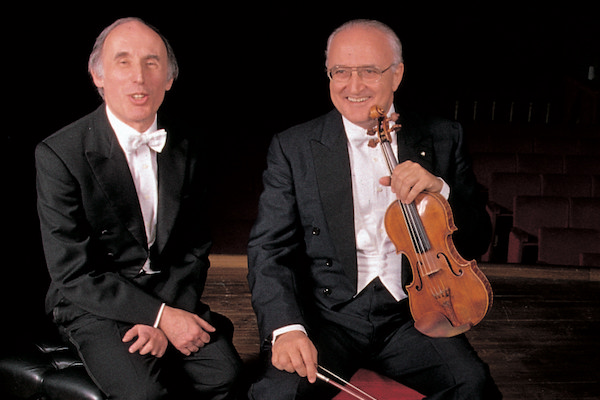 Salvatore Accardo
Salvatore Accardo
born September 26, 1941 in Turin, northern Italy) is an Italian violin virtuoso and conductor.
Accardo studied violin in the southern Italian city of Naples in the 1950s. He gave his first professional recital at the age of 13 performing Paganini's Capricci. In 1956 Accardo won the Geneva Competition and in 1958 became the first prize winner of the Paganini Competition in Genoa.
He has recorded Paganini's 24 Caprices (re-recorded in 1999) for solo violin and was the first to record all six of the Paganini Violin Concertos. He has an extensive discography of almost 50 recordings on Philips, DG, EMI, Sony Classical, Foné, Dynamic, and Warner-Fonit. Notably, he has recorded an album of classical and contemporary works in 1995 on Paganini's Guarneri del Gesù 1742 violin, the "Canon".
Accardo founded the Accardo Quartet in 1992 and he was one of the founders of the Walter Stauffer Academy in 1986. He founded the Settimane Musicali Internazionali in Naples and the Cremona String Festival in 1971, and in 1996, he re-founded the Orchestra da Camera Italiana (O.C.I.), whose members are the best pupils of the Walter Stauffer Academy. He performed the music of Paganini for the soundtrack of the 1989 film Kinski Paganini. In the 1970s he was a member of the celebrated Italian chamber orchestra "I Musici".
Accardo owns one Stradivarius violin, the "Hart ex Francescatti" (1727) and had the "Firebird ex Saint-Exupéry" (1718).
Bruno Canino
Born in Naples, Bruno Canino studied piano and composition at the Conservatorio Verdi in Milan, where he taught solo piano for 24 years. He has performed both as a soloist and a chamber musician in all the great concert venues of Europe, the United States, Australia, Japan and China. For over forty years he has been regularly performing with Antonio Ballista, his piano duo partner, and for some thirty years he has been a member of the Trio of Milan.
Bruno Canino is deeply interested in contemporary music and has collaborated with such distinguished composers as Pierre Boulez, Luciano Berio, Karlheinz Stockhausen, György Ligeti, Bruno Maderna, Luigi Nono, Sylvano Bussotti and others, the works of whom he has often premièred.
Bruno Canino’s recent recordings include the Goldberg Variations, the complete piano works by Casella, and the complete Debussy piano works. In 1997 Passigli Editions published his book Vademecum for a Chamber Pianist.











